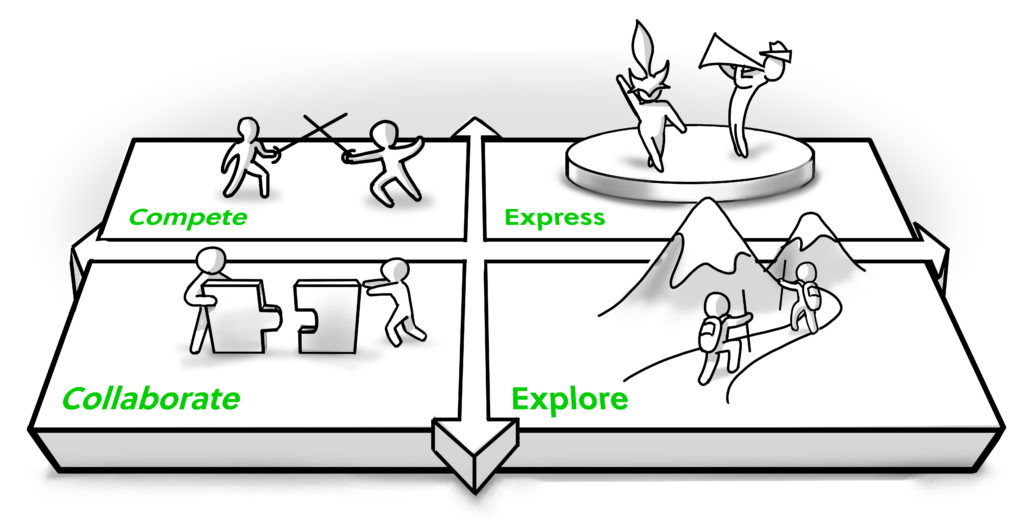Beyond Player Types: Kim’s Social Action Matrix
Human nature is complex – and personality types are convenient simplifications. that help us understand people’s different temperaments, motivations and social styles. Like many game designers, I’ve found Bartle’s Player Types useful, especially for MMOs and online competitive games. A key value of Bartle’s system is to raise awareness that different people enjoy different types of fun. It’s also useful for de-bugging some of the more simple-minded thinking around gamification – particularly the limited appeal of Achiever-style point, badges and levels.
Yet when I’ve applied Bartle’s system to casual, social and educational games, it wasn’t always a good fit. For example, I was working on casual games for a high-traffic women’s portal, and we found that the “Killer” archetype was almost non-existent in their player base. Apparently, teenage male hackers aren’t drawn to harass a site full of Moms. Go figure 🙂
Inspired by Bartle, I took my experience building and playing successful – and NOT so successful – social games and services, and identified four key patterns: Compete, Collaborate, Express and Explore.
 I find it useful to map these out as Social Actions, or Verbs – because as product builders, we can enable these actions by offering specific features and systems. Here are some common Verbs that cluster into these quadrants.
I find it useful to map these out as Social Actions, or Verbs – because as product builders, we can enable these actions by offering specific features and systems. Here are some common Verbs that cluster into these quadrants.

For the purpose of mapping these verbs to personality systems, and better understanding player motivation, let’s look at each Verb as a Player Type.
Competitors are motivated by testing their skills and seeing how they stack up. They find external ranking systems and zero-sum game mechanics appealing because those structures mirror their internal dialogue and POV. Competitors love to develop their skills, showcase their prowess, and know where they stand within a group. They value mastery, learning, and relationship-building via friendly competition.
Collaborators are motivated by working with others towards a greater goal. They love to “win together” and measure success as collective impact. Collaborators enjoy participating in groups and teams, forming partnerships, and playing coop games. They value teamwork, shared learning, and relationship-building via shared tasks.
Expressers are motivated by opportunities for self-expression. They love tools and systems that let them personalize their experience, make their mark, and express their uniqueness. They’ll use any available tools to make things that others admire and emulate. They value original thought, creativity, hard work, and personal style. They enjoy customizing backgrounds, fonts, and avatars. They seek status, recognition, and influence through creative skill
Explorers are motivated by gaining knowledge, exploring boundaries, finding loopholes, and knowing the rules that govern a space. Explorers love to poke at systems and discover their ins-and-outs. They enjoy accumulating and showing off knowledge. Explorers value accurate info, clever design, and relationship-building via knowledge exchange. They can enjoy exploring with others, but often it’s a satisfying solitary endeavor.
And there you have it: a simple, practical system describing common motivational patterns in social and casual games. I’ve used this system productively with many clients for product strategy, feature planning, and user experience de-bugging. That said, no model offers the ultimate solution – so think of this Matrix as a starting point for understanding and analyzing what motivates your players. Try using it to design experiences that will delight and engage your players by targeting these core motivations. Don’t be afraid to tweak this model to make it apply more specifically to your audience and application – I do it the time. 🙂
Want more? My new book, the Game Thinking playbook, will be published in May 2018. You can learn more and read excerpts from the book right now by signing up for the early-bird list here.

Fitfunner and Gaming | Fitfunner
March 9, 2014 @ 12:52 pm
[…] we came across a post by Amy Jo Kim that has been giving us a lot to think about. If you haven’t heard about Amy Jo, […]
Intraplayer Variability Done the Fitfunner Way | Fitfunner
March 16, 2014 @ 1:23 am
[…] Anna here again with a follow up on our earlier post on the Social Action Matrix, as first described by Amy Jo Kim. […]
March 27, 2014 @ 3:05 am
Amy,
Great article (as usual 🙂 ). As a Creator, I thought I would broaden your definition slightly. In many cases, Creators are intrinsically motivated. While many may “seek status, recognition and influence”, there are also many who Create for the joy of creating and don’t really care about status and influence. That diversity is part of what makes it fun!
Players without Archetypes | Start My Quest
April 17, 2014 @ 9:52 pm
[…] within myself, this kind of fluid action is captured by Social Game Designer, Amy Jo Kim’s social action matrix, which explicitly removes any player archetypes in favour of […]
Gamification Laid Bare | +Play
May 29, 2015 @ 10:38 pm
[…] inherent motivations, suggesting Bartle’s useful analysis as a framework. (Amy Jo Kim has some useful things to say on this as […]
ID and E-Learning Links (8/23/15) | Experiencing E-Learning
August 23, 2015 @ 1:30 pm
[…] Beyond Player Types: Kim’s Social Action Matrix […]
Engagement design in 24 step
November 7, 2023 @ 9:53 am
[…] singoli step. Ho studiato frameworks eccellenti che vorrei menzionare: Octalysis by Yu-Kai Chou, the social engagement verbs by Amy Jo Kim, the four keys to fun by Nicole Lazzaro, the book of Prof. […]
Engagement design in 24 step
January 4, 2024 @ 1:31 pm
[…] I’ve studied excellent frameworks that I would like to mention: Octalysis by Yu-Kai Chou, the social engagement verbs by Amy Jo Kim, the four keys to fun by Nicole Lazzaro, the book of Prof. […]